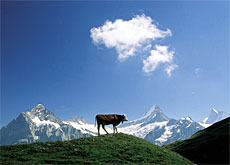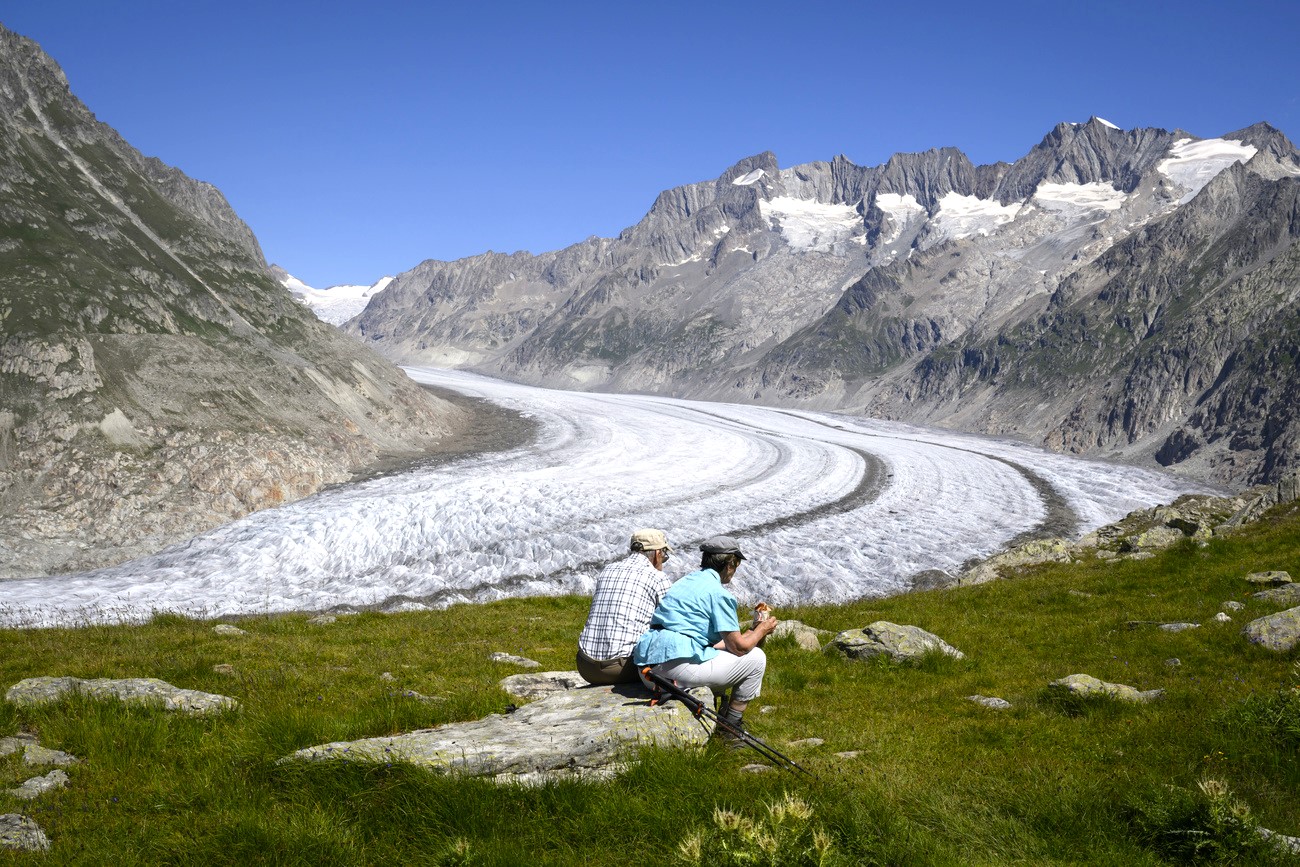Farming bears fruit for tourism in Grindelwald

Grindelwald is one of the few large resorts in the Alps where farming has been able to survive and co-exist alongside a dominant tourist industry.
The Bernese Oberland village has for decades benefited from a fragile symbiosis between agriculture and tourism.
“Tourism needs agriculture and agriculture needs tourism,” says Grindelwald farmer Sämi Brawand.
On his six-hectare farm above the village, Brawand and his wife attend to eight head of dairy cattle and, when they are done with the farm chores, wait on customers at their small restaurant.
A ski lift is the only thing separating the barn from the restaurant and the lift operator pays Brawand’s farming cooperative for the rights to run the lift on its land.
Grindelwald still has about 150 farms which account for about 80 per cent of all land use, even though the number of farms has decreased over the past 20 years in favour of larger farms averaging at least 15 hectares.
And nearly all of the farmers are involved directly in tourism. The Brawands for example derive about half of their income from the restaurant.
Complex laws
Indeed, more than 90 per cent of the resort’s turnover is generated by tourism. Part of that income is reinvested in agriculture, as required and regulated by complex laws on land use dating back centuries.
The village is divided into seven cooperatives, or “Bergschaften”, each of which administers an area of the centre and the farmland extending to the upper alpine meadows.
The cooperatives collect dues from the hotel and shop owners and ski lift and railway companies operating on their land. The fees in turn subsidise the mountain farming.
The tourist industry benefits because farmers preserve the picturesque pastoral landscape.
“If farming were to disappear, the landscape would be completely altered,” says Brawand. “Everything would be overgrown and forests would slowly encroach on the pastureland.”
A resort apart
Studies conducted at Bern University over the past two decades show that the rural landscape sets Grindelwald apart from other large alpine resorts like Zermatt or St Moritz where farming is insignificant.
Urs Wiesmann of the university’s geography institute says Grindelwald is unique in ecological, sociocultural and economic terms.
“You will find similar things in other places, but never in this complete combination as you find in Grindelwald,” Wiesmann says.
He adds that agriculture also acts as a social bond for the people of the community, enabling them to retain their identity in the face of the urban culture that comes with tourism.
Brawand says it is pride that keeps him farming because his working day would be far shorter, if he gave up on the land and concentrated solely on catering to tourists.
Ghost town
“We don’t want to depend completely on tourism,” he says. “If we did so, as elsewhere, residents would abandon the village in the off season, turning it into a ghost town.”
However, Wiesmann says tourism alone is not enough to protect the village’s farming community from further liberalisation measures planned by the Swiss government, which include removing milk quotas and reducing export subsidies.
“It’s difficult to say where Grindelwald is headed but it’s faced with the challenge of maintaining its niche or developing into a purely mainstream resort,” he warns.
“In the second scenario, it will face much stiffer competition and therefore turnover will decrease.”
Wiesmann says there is a trend towards larger, centralised farms. “Quite a number of traditional houses situated within the old settlement structure might be abandoned,” he adds.
“I don’t know what’s going to happen,” says Brawand. “I can imagine more people will give up their farms over the next five or six years, and they will be leased to others.
“I think there will be land that won’t be farmed as intensively as before, but it will still be cultivated.”
And even in a worst-case scenario, Wiesmann says Grindelwald will survive as a tourist resort.
“There’s no doubt about that unless the Eiger [mountain above the village] crumbles.”
swissinfo, Dale Bechtel in Grindelwald
Grindelwald has a year round population of 4,500, and 12,000 guest beds.
It has about 150 farms.
The village lies at the foot of three of Switzerland’s most famous mountains, the Eiger, Mönch and Jungfrau.
According to the Federal Agriculture Office, Swiss farms will continue to close at a rate of up to 3% per year.
The findings on Grindelwald resulted from a scientific study that began in the 1980s (see link).
The Man and the Biosphere Grindelwald project carried out by Bern University was a Unesco research programme designed to show the relation between economic activities, land use and ecological balance in mountain areas.
It was financed by the Swiss National Science Foundation.

In compliance with the JTI standards
More: SWI swissinfo.ch certified by the Journalism Trust Initiative











You can find an overview of ongoing debates with our journalists here . Please join us!
If you want to start a conversation about a topic raised in this article or want to report factual errors, email us at english@swissinfo.ch.